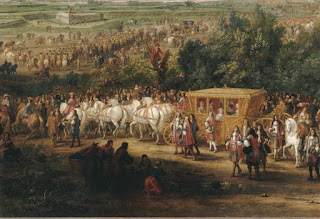Of course, I've already spoke about Spotted horse history and demonstrate how they were plenty of them in French royalty,
But let's talk again about this, and more about the horses itselfs!
The Stables
"All European Princes would have done of them a palace, and they were 'only' the French King Stables", located directly front of the Versailles Palace, no more was needed to highlights the importance of horses as they represent power!
 |
| "Perspective view from the Chateau of Versailles" by Jean Baptiste Martin Showing the two stabbles in the back. |
All of them were great institution, with a lot of different workers and... horses!
 |
| Stalls from "The small stabbles" by J.G Rosenberg |
In a first time, the ground was made with wooden floor then replaced by rock pavement, more dommageable to the horses legs but more hygienic too.
Horses were also "displayed" in a way that the sun cannot hurt their eyes.
The Horses
Hundred of horses lives at Versailles, all lined up by color and breed.
Spanish, Arab and Persian horses for ceremonials; parades and carrousels.
 |
| "Enter of Charles X at Paris, from his sacre at Reims, 6 June 1825" (detail) by Louis François Lejeune |
 |
| "Napoleon the first wedding with Marie Louise, archiduchess" (detail) by Etienne-Bathélémy Garnier |
 |
| "The Grand Finale" (unknown) |
 |
| "Spanish horse" |
 |
| "Arabian horse" |
English steeds for the hunts.
 |
| "The death of the deer at St Jean au Bois lake pond" by Jean Baptiste Oudry |
 | |
|
 |
| "Meeting at Compiègne" by Jean Baptiste Oudry |
 |
| "Arrival of the royal coach at the Ambassador stairs" by Charles Parrocel |
 |
| "Danish horse" breed for the Polish Cavalry |
 |
| "Crossing the Rhine by the army of King Louis XIV" by Joseph Parrocel |
 |
| "King Louis XIV at the siege of Lille facing the Priority of Five" Adam Frans van der Meulen |
 |
| "View of the Versailles Castles from Satory" by Adam Franz Van der Meulen |
Golden Age of the French Riding
Art of dressage for French tradition was searched and perfectionned in the "great" stabble riding arena. The idea was about to let the horse it's natural grace and attitude, with perfect harmony between the horse and the rider. The French equery art at Versailles was known in the whole Europe and benefited at the kingdom prestige!
*
Bonus: Carriages at Versailles, vids.
 | ||
| "Solennel entry of King Louis XIV and Queen Marie Thérèse at Arras, 30 july 1667" by Adam Franz Van der Meulen |
And I let you on this excellent video we saw at the expo:









Très intéressant !
RépondreSupprimerSurtout de voir que la majorité des races de cette époque étaient tachées !! ^^